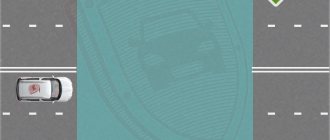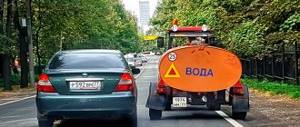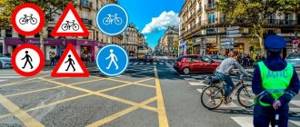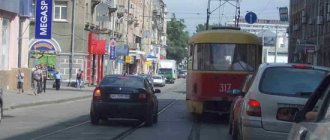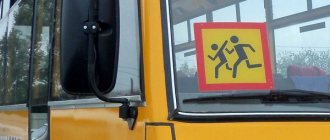The highway is marked in the traffic rules with sign 5.1.
It is a highway for motor vehicles, where certain rules apply.
It has many lanes for traffic, as well as wide shoulders. Opposite directions of movement are separated by a dividing line or fence.
You must drive along such a road in compliance with certain rules . Thus, stopping on the highway is allowed in certain places, and you can drive at a certain speed limit.
Traffic rules
Distinctive features of the highway are the presence of markings and the absence of intersections with single-level roads.
These features make the highway safer and reduce the likelihood of accidents.
In this regard, certain rules apply on this type of road. They are enshrined in clause 16 of the traffic rules.
The width of one travel lane is 3.75 m, with a minimum of 2 lanes for each direction.
All information and directional signs on such a route have a green background.
The car enters the highway from a special acceleration lane and leaves from the braking lane.
You can drive on the highway at a speed of no more than 110 km/h, this is written in paragraph 10.3 of the traffic rules. This regime applies outside populated areas. When entering them, the driver must slow down to 60 km/h.
On a small number of motorways, driving speeds of up to 130 km/h have been allowed since 2013. – the driver is notified about this by signs with the indicator “130”.
The minimum permissible speed on the highway is not specified in the traffic regulations.
According to the general requirement, the car must be able to travel at a speed of 40 km/h.
It can be reduced, however, this increases the likelihood of a collision, since the driver of a car speeding at high speed may not notice a slow-moving participant.
Parking under a “No Parking” sign is not always a violation. You can find out about the sign's coverage area and the amount of fines for parking violations here.
It would not be amiss to remember the coverage area and exceptions of the “No Stopping” sign.
Is parking allowed on the lawn in winter? The answer is in the material.
You can make a U-turn on the highway at the junctions provided for this purpose: bridges, tunnels and overpasses.
On motorways, drivers should drive in the right lane whenever possible, and use the left lane when necessary, both when driving through a populated area and beyond its borders.
Pedestrians can cross the highway only through underground or overground crossings.
The traffic rules clause, which allows people to cross a highway outside of specially designated places, if there is no equipped crossing or controlled intersection in sight, does not apply to the highway.
According to clause 9.4 of the traffic rules on the highway, the car must drive in the right lanes.
Fine for reversing on a motorway
Due to the fact that the highway has all the conditions for high-speed and dense traffic, performing a reverse maneuver is guaranteed to lead to an emergency situation. That is why clause 16.1 of the traffic rules clearly states the prohibition of reversing on the road marked with sign 5.1.
What is the fine for driving in reverse on a highway established by the legislator? Penalties for such a maneuver amount to 2,500 rubles. (Part 3 of Article 12.11 of the Administrative Code).
At the same time, the fact that you do not see a traffic police officer nearby does not mean impunity for those who decide to commit this violation. The fact is that on most busy highways in Russia, video recorders are installed, which are precisely designed to detect such situations. So don’t be surprised if, after a successful (i.e., accident-free) maneuver of this kind, you soon receive a notice of a fine for driving in reverse on a motorway.
If the maneuver turned out to be unsuccessful, in this case we advise you to read the article “Are the culprit of the accident entitled to payments under compulsory motor liability insurance?”
Subscribe to our newsletter
Yandex.Zen VKontakte Telegram
Highway bans
When entering a highway, every driver must remember that there are certain rules associated with many restrictions.
On the motorway it is not permitted to drive at speeds below 40 km/h.
This limitation applies to all vehicles that cannot reach this speed due to technical parameters or malfunction. There is no traffic allowed on a road with sign 5.1:
- passers-by and livestock;
- mopeds, tractors and self-propelled mechanisms;
- motorcycles with an engine capacity of less than 50 cc. cm.;
- trucks weighing more than 3.5 tons, to the left of the second lane;
- other vehicles that cannot travel faster than 40 km/h;
- educational cars, if the driver is a student.
In accordance with the traffic rules, the above vehicles and persons should not travel along the highway for their own safety, since high speeds prevail on this road. Their appearance can destabilize the movement regime.
Restrictions on trucks entering the left lane are necessary to maintain good highway capacity.
You can stop on the highway only at special sites equipped for this. Due to the heavy traffic flow, turning around on the highway is prohibited (Section 16.1 of the Traffic Regulations).
Today there are several ways to check for fines by car number. Each of them has its own characteristics, positive and not so good sides.
You can pay traffic fines through a bank, the Internet, or even SMS. You can learn more about each of the possible payment methods here.
Driving into technical breaks in the demarcation line is not permitted, with an exception made for vehicles with flashing lights that are carrying out repair work or performing urgent tasks.
It is prohibited to drive in reverse on the highway, as this may interfere with vehicles traveling at high speed.
Violation of one of the above restrictions is punishable by a fine of 1,000 rubles. up to 2,500 rub.
The following types of transport are prohibited from speeding above 90 km/h on the motorway:
- vehicles with trailers;
- trucks with a permissible weight above 3.5 tons;
- motorcycles;
- buses (intercity, small, etc.);
When transporting citizens, cars should not travel faster than 60 km/h; in the case of towing, this limit is 50 km/h.
You cannot pick up or drop off people on the expressway.
What is a motorway
A motorway is a road that is intended for high-speed traffic, on which oncoming traffic lanes are separated by a median strip, and which does not have grade-level intersections with other roads, railway or tram tracks, pedestrian or bicycle paths.
However, not every road that fits the above definition is a highway. In addition, there must be a road sign indicating the beginning and end of the highway section. Without this sign, the road does not become a motorway.
According to clause 1.2 of the Russian Traffic Regulations, a highway is a road marked with sign 5.1.
Accordingly, if you drove past sign 5.1, you are on the motorway, but if you crossed sign 5.2, then you are no longer on the motorway, and it doesn’t matter what the road itself looks like.
Stop on the motorway
You can stop on the highway only in specially created areas - they are indicated by appropriate signs (parking spaces, parking areas, recreation areas), which are installed at a distance of 500 m from the stopping areas so that the driver can begin to reduce speed and prepare for the exit. road and stop.
Such parking lots are located at an impressive distance from each other, so the motorist must plan the place and time of the stop, especially at night.
Stopping on a highway beyond the line indicating the edge of the highway, as well as in the acceleration and braking lanes, is strictly prohibited.
In case of a necessary stop, for example, in the event of a breakdown, you should turn on the emergency lights and install an emergency traffic stop sign.
The driver must remove the car from the roadway beyond the right limit line as quickly as possible or, with the help of other drivers, tow it to the nearest parking lot.
Behind the limit line you should also highlight your car with the emergency lights on and the corresponding sign.
If a forced stop occurred due to poor health of the driver, passengers must drive the car off the roadway. If they are absent, drivers passing by should stop and help the person.
It is better to install an emergency sign away from a broken down car so that other drivers can get around the stationary car in time.
Article 12.20 of the Administrative Code provides for a fine of 500 rubles. for failure to comply with the rules for using emergency signs, alarms, sound and lighting devices.
Fine for driving on a motorway on a moped
Although there are mopeds that can reach speeds of 50–75 km/h, the legislator nevertheless introduced a ban on the movement of this type of transport on the highway. In clause 16.1 of the traffic rules it is clearly stated that it is forbidden to move on such a route on a moped.
Some drivers are interested in whether the ban applies to those who have a scooter according to the technical documentation. If you look at the description of the moped in clause 1.2 of the traffic rules, it becomes clear that driving it on the highway is also prohibited. In the interpretation of the traffic rules, a moped is a two-wheeled mechanical vehicle with a displacement of an internal combustion engine of more than 50 cm3 or an electric motor, the maximum power of which at load ranges from 0.25 to 4 kW. That is, from the point of view of traffic rules, a scooter and a moped are one category of vehicle.
Thus, if a traffic police officer (or a car camera) records a driver moving along a road marked with sign 5.1 on a moped, the violator will be fined. According to the same part 1 of Art. 12.11 Code of Administrative Offences, the fine will be 1000 rubles.
Penalty for riding a bicycle on a motorway
Motorways are marked with sign 5.1. Such a road consists of several lanes in each direction, separated from each other by special fences or wide dividing strips. Motorways do not cross railways, trams, bicycle paths or pedestrian paths.
A characteristic feature of such highways is that they allow the movement of cars at high speeds - up to 110 km/h or, by decision of the owners or possessors of the road, up to 130 km/h (within populated areas - 60 km/h) and a limit has been introduced on the minimum speed — 40 km/h. Such a restriction helps ensure the safe movement of the most technically powerful vehicles (hereinafter referred to as vehicles).
In this regard, it becomes clear why you cannot ride a bicycle on the highway: it is simply impossible to develop and maintain the required speed on this vehicle for a long time. If a bicycle appears on the highway, it will become an obstacle for fast moving cars and create an emergency situation. That is why in the Traffic Rules, approved. Government Decree No. 1090 dated October 23, 1993 introduced clause 16.1.
As one of the penalties, a fine has been introduced for riding a bicycle on the highway. If a cyclist passes on a highway, he may be fined 1,000 rubles, according to Part 1 of Art. 12.11 Code of Administrative Offenses of Russia.

